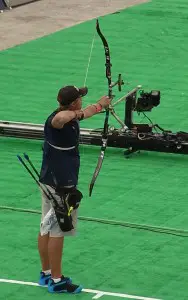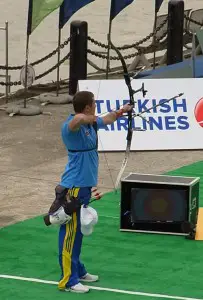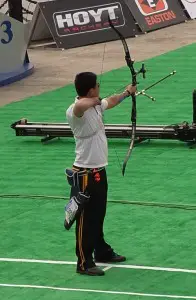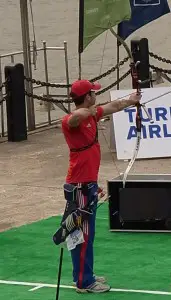 When people watch archery on TV or YouTube they tell themselves that archery seems to be quite an easy sport to play as all you have to do is draw a string and let the arrow fly. Actually, you might be surprised to know that many people think archery is not a physically challenging sport, when, on the contrary, once you reach past the beginner’s level, it gets harder and harder to draw a high-poundage bow.
When people watch archery on TV or YouTube they tell themselves that archery seems to be quite an easy sport to play as all you have to do is draw a string and let the arrow fly. Actually, you might be surprised to know that many people think archery is not a physically challenging sport, when, on the contrary, once you reach past the beginner’s level, it gets harder and harder to draw a high-poundage bow.
As in most sports, the athlete needs body strength to achieve a high performance and the muscle groups needed to do this vary from sport to sport. Another misconception regarding archery is that all you need to draw a “strong bow” is big biceps. Again, the exact opposite is the actual truth, as big biceps on the bow arm would only be in the way of your string when released and, in the case of the string arm, they would impede a correct hooking form.
To reach a full draw (the moment just seconds before you release the arrow) you need to follow several steps, such as raising the bow, drawing the bow, hooking, and aiming. Experienced archers go through these steps without actively thinking about them and thus their body (both muscles and mind) remember the archer’s best/correct shooting form from hours and hours of practice. For beginners, this situation is a bit different and although with proper coaching you can reach a good shooting form, I have realized that understanding why you have to shoot a certain way helps you correct and improve your form.
I mean, the coach can tell you hundreds of times to use your back muscles when you draw the bow, but no matter how many times you hear it, you still clench your fingers when you draw it. By learning about the anatomy of the human body, especially the bones and muscles used in archery, you can correct your form following a bad shot by understanding what muscle didn’t do its job.
The four major muscle groups where strength is needed for a correct archery posture and shooting form are your back, shoulder, arm, and leg muscles. Below, I break down each group into specific muscles and tasks that an archer needs to apply in order to score a bull’s eye.
 1) Upper back and shoulder muscles
1) Upper back and shoulder muscles
The most crucial moment in archery is not the moment when you aim but rather the part when you draw your bow. The muscles that should be used when drawing your bow are the ones in your upper back and shoulders and, if used correctly, they can assure not only balance and stability, but also a good arrow release and follow-through.
Imagine you are now at that crucial moment, the bow is already lifted and what you need to do next is draw your bow. The muscle in your upper back that you must use is the trapezius muscle, a large muscle that stretches from your neck to approximately halfway down your spine. The trapezius is in charge of moving the scapula (or the shoulder blade) inwards, preparing the tension needed for the moment when you release your arrow.
While you are locking your bow arm (that is, setting the scapula of the bow arm in position) you make a circular movement with the shoulder of your string arm. The muscle involved in this circular movement is the deltoid muscle, which makes the round contour of your shoulder. (It is at this point when the uninformed think that the biceps come into play.) Once the circular movement has brought your string hand close to your jaw, the archer needs to employ the trapezius muscle of the string arm and position the scapula in a mirror-like position with the scapula on the side of your bow arm.
The trapezius and the deltoid muscles are also used to control the movement of the bow arm, so that it is steady in the moments preceding aiming and the release of the arrow.
While the upper back and shoulder muscles help you draw the bow, your arm muscles will aid you in extending the bow arm. Now, you must take into consideration that the average draw weight of a semi-pro archer is around 42 lbs, which requires a heightened strength of the muscles you use. Thus, extending the bow arm and keeping the shoulder in line and the scapula inwards is not as easy as it might seem. Actually, if strength in either your back, shoulder or arm muscles is lacking, you’d most likely end up in a “bad shooting position” with, let’s say, the shoulder of your bow arm raised or your bow arm twisted outward, instead of inward (thus raising the chances of being hit by the string on your forearm).
To prevent this, you must have a “steady and strong” arm, which means your bow arm must employ the use of the brachioradialis muscle. This specific muscle is used in flexing the forearm at the elbow, but in the case of setting up your bow arm for a shooting position, the muscle will help the forearm undergo supination (rotation of the forearm so that the palm faces forward).
Once supination has taken place, you need to stretch out the arm by using the flexor carpi radialis muscles, located along the radius bone in your forearm (from the lateral side of the elbow to your thumb) and the flexor carpi ulnaris muscle, located alongside the ulna bone (parallel to the radius).
At this point, your trapezius muscle has already turned the scapula inwards and thus placed the shoulder of the bow arm on the same line as the bow arm. While this happens, your string arm will be making use of your triceps muscles to extend the elbow outward, thus bringing the finger tab in position under your chin. The triceps work hand in hand with the circular shoulder movement while the upper body is locked in this position with the use of the trapezius muscle and the positioning of the scapula. (Take note that the biceps is not used at all!)
Holding the string is of course done with the use of the fingers and the groups of muscles that aid finger movement, but the hand should be relaxed and no specific muscle should be given emphasis. If this is done correctly or not can be easily observed by your coach or fellow archers: the outline of the phalanges will be easily seen through the skin of your hand as you pull the string with your finger/biceps rather than your back muscles and shoulders.
To adjust a straight body posture you will have to keep your waist on the same line with your torso. On many occasions, when your body strength doesn’t match the drawing power of our bow, the body tends to compensate the force in the bow with your waist going the opposite side of your drawing hand. You can adjust this unwanted movement (which makes the archer look like the letter C) by employing your waist and lower back muscles to keep your torso and legs on the same vertical line.
4) Leg muscles
A successful shot not only depends on the skillful use of your upper body and arm muscles, but also of your leg muscles which are employed to control your balance. Regardless of the position of your feet astride the shooting line, to maintain your balance and steadiness of your entire body you will need to use your upper and lower leg muscles.
The upper leg muscles used are the quadriceps femoris or your tight muscles located in front of your legs and the gluteal (they make up your buttocks) and hamstrings (tight muscles) located in the posterior side.
The lower leg muscles that help you control the back and forth movement of your body are the tibialis anterior muscles, near the shins in front, and the calf muscles which form the back part of the lower leg, connecting to the heel muscles.
So, next time when you go to the gym, give these muscle groups special attention. Your strength training should be balanced and not concentrated on the bow arm only, but you should rather follow the same exercise routine with both the left and right hand/muscles. As you build body strength, you’ll find it easier to draw your bow and thus you’ll have a better chance of scoring a bull’s eye. Know thy muscles and you will achieve!




Great article! I’ll share it on our facebook so that the members could read. Hope you don’t mind 😀
I’m grateful for your feedback.
Even though an archery coach (three years Mauritius Olympic Committee and International Olympic Committee) of recurve archery, I constantly seek out information. Your article impressed me with its simple and direct identification of muscle groups.
Identifying the major (and minor) muscles involved, help to concentrate attention on what should be focused on.
The way that you have presented your information, is to be congratulated.
By separating the sections, you enable trainers and coaches, to correctly concentrate on the specific exercises required to support the athletes’ progress.
Well done and a personal thank you.
Coach Krish Rama.